Case Study: Assessment and Management of Severe Paranoia in an Elderly Patient
VerifiedAdded on 2023/06/06
|9
|2408
|155
AI Summary
This blog discusses the assessment and management of severe paranoia in an elderly patient through a case study. It covers the necessary information to be gathered, important immediate issues, and the possible condition of the patient. The blog also suggests how the health service should respond to the patient's condition.
Contribute Materials
Your contribution can guide someone’s learning journey. Share your
documents today.
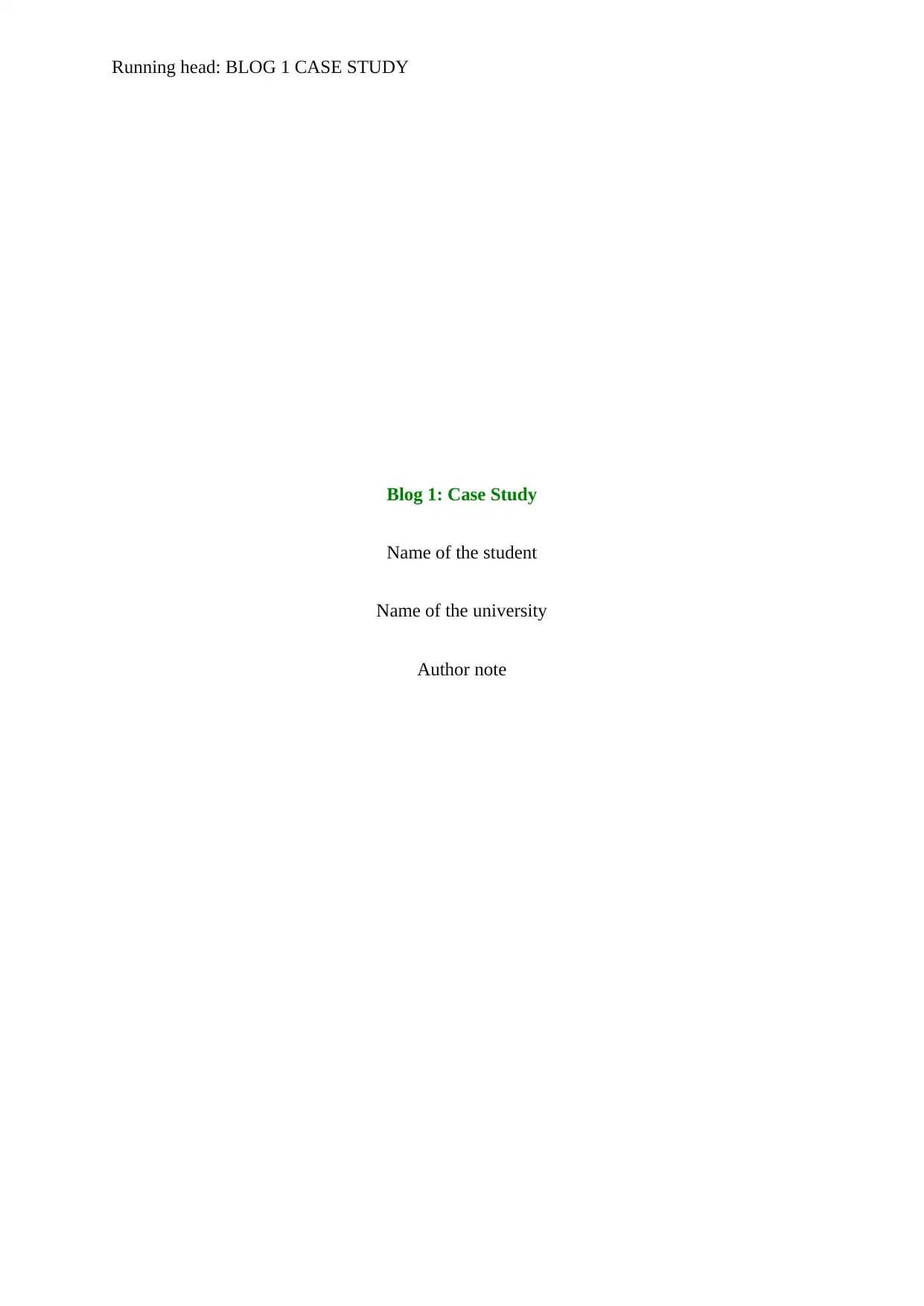
Running head: BLOG 1 CASE STUDY
Blog 1: Case Study
Name of the student
Name of the university
Author note
Blog 1: Case Study
Name of the student
Name of the university
Author note
Secure Best Marks with AI Grader
Need help grading? Try our AI Grader for instant feedback on your assignments.
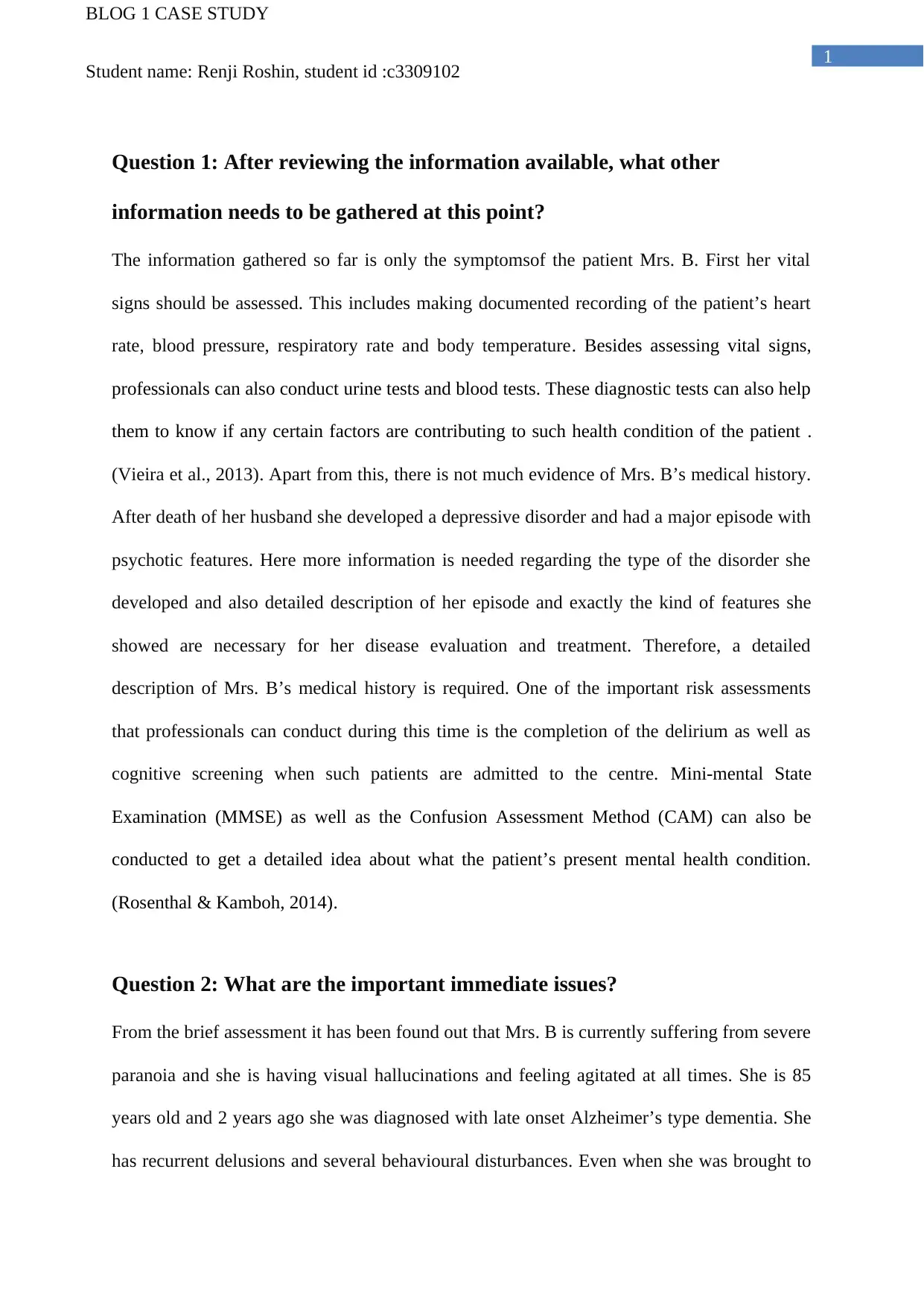
1
BLOG 1 CASE STUDY
Student name: Renji Roshin, student id :c3309102
Question 1: After reviewing the information available, what other
information needs to be gathered at this point?
The information gathered so far is only the symptomsof the patient Mrs. B. First her vital
signs should be assessed. This includes making documented recording of the patient’s heart
rate, blood pressure, respiratory rate and body temperature. Besides assessing vital signs,
professionals can also conduct urine tests and blood tests. These diagnostic tests can also help
them to know if any certain factors are contributing to such health condition of the patient .
(Vieira et al., 2013). Apart from this, there is not much evidence of Mrs. B’s medical history.
After death of her husband she developed a depressive disorder and had a major episode with
psychotic features. Here more information is needed regarding the type of the disorder she
developed and also detailed description of her episode and exactly the kind of features she
showed are necessary for her disease evaluation and treatment. Therefore, a detailed
description of Mrs. B’s medical history is required. One of the important risk assessments
that professionals can conduct during this time is the completion of the delirium as well as
cognitive screening when such patients are admitted to the centre. Mini-mental State
Examination (MMSE) as well as the Confusion Assessment Method (CAM) can also be
conducted to get a detailed idea about what the patient’s present mental health condition.
(Rosenthal & Kamboh, 2014).
Question 2: What are the important immediate issues?
From the brief assessment it has been found out that Mrs. B is currently suffering from severe
paranoia and she is having visual hallucinations and feeling agitated at all times. She is 85
years old and 2 years ago she was diagnosed with late onset Alzheimer’s type dementia. She
has recurrent delusions and several behavioural disturbances. Even when she was brought to
BLOG 1 CASE STUDY
Student name: Renji Roshin, student id :c3309102
Question 1: After reviewing the information available, what other
information needs to be gathered at this point?
The information gathered so far is only the symptomsof the patient Mrs. B. First her vital
signs should be assessed. This includes making documented recording of the patient’s heart
rate, blood pressure, respiratory rate and body temperature. Besides assessing vital signs,
professionals can also conduct urine tests and blood tests. These diagnostic tests can also help
them to know if any certain factors are contributing to such health condition of the patient .
(Vieira et al., 2013). Apart from this, there is not much evidence of Mrs. B’s medical history.
After death of her husband she developed a depressive disorder and had a major episode with
psychotic features. Here more information is needed regarding the type of the disorder she
developed and also detailed description of her episode and exactly the kind of features she
showed are necessary for her disease evaluation and treatment. Therefore, a detailed
description of Mrs. B’s medical history is required. One of the important risk assessments
that professionals can conduct during this time is the completion of the delirium as well as
cognitive screening when such patients are admitted to the centre. Mini-mental State
Examination (MMSE) as well as the Confusion Assessment Method (CAM) can also be
conducted to get a detailed idea about what the patient’s present mental health condition.
(Rosenthal & Kamboh, 2014).
Question 2: What are the important immediate issues?
From the brief assessment it has been found out that Mrs. B is currently suffering from severe
paranoia and she is having visual hallucinations and feeling agitated at all times. She is 85
years old and 2 years ago she was diagnosed with late onset Alzheimer’s type dementia. She
has recurrent delusions and several behavioural disturbances. Even when she was brought to
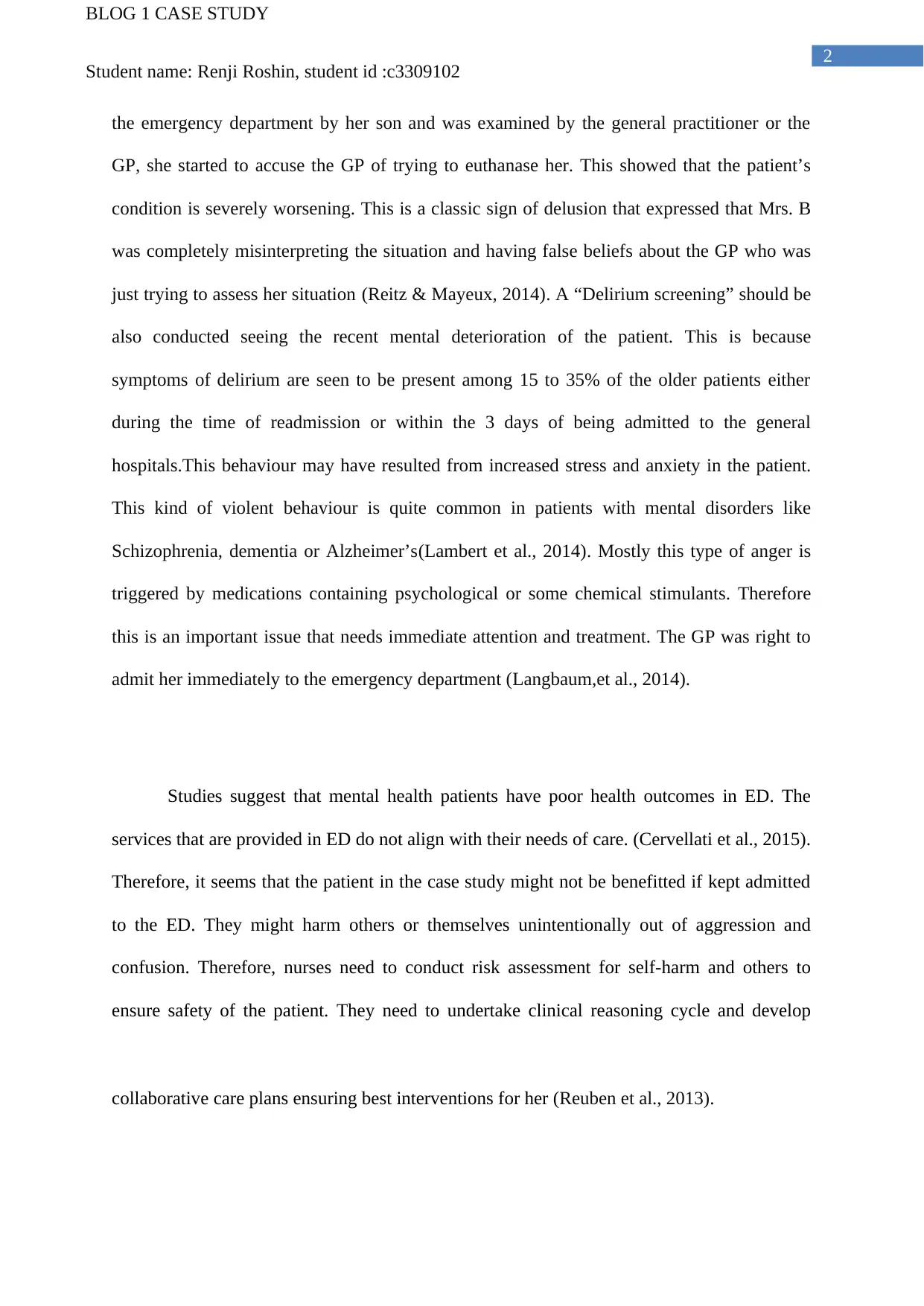
2
BLOG 1 CASE STUDY
Student name: Renji Roshin, student id :c3309102
the emergency department by her son and was examined by the general practitioner or the
GP, she started to accuse the GP of trying to euthanase her. This showed that the patient’s
condition is severely worsening. This is a classic sign of delusion that expressed that Mrs. B
was completely misinterpreting the situation and having false beliefs about the GP who was
just trying to assess her situation (Reitz & Mayeux, 2014). A “Delirium screening” should be
also conducted seeing the recent mental deterioration of the patient. This is because
symptoms of delirium are seen to be present among 15 to 35% of the older patients either
during the time of readmission or within the 3 days of being admitted to the general
hospitals.This behaviour may have resulted from increased stress and anxiety in the patient.
This kind of violent behaviour is quite common in patients with mental disorders like
Schizophrenia, dementia or Alzheimer’s(Lambert et al., 2014). Mostly this type of anger is
triggered by medications containing psychological or some chemical stimulants. Therefore
this is an important issue that needs immediate attention and treatment. The GP was right to
admit her immediately to the emergency department (Langbaum,et al., 2014).
Studies suggest that mental health patients have poor health outcomes in ED. The
services that are provided in ED do not align with their needs of care. (Cervellati et al., 2015).
Therefore, it seems that the patient in the case study might not be benefitted if kept admitted
to the ED. They might harm others or themselves unintentionally out of aggression and
confusion. Therefore, nurses need to conduct risk assessment for self-harm and others to
ensure safety of the patient. They need to undertake clinical reasoning cycle and develop
collaborative care plans ensuring best interventions for her (Reuben et al., 2013).
BLOG 1 CASE STUDY
Student name: Renji Roshin, student id :c3309102
the emergency department by her son and was examined by the general practitioner or the
GP, she started to accuse the GP of trying to euthanase her. This showed that the patient’s
condition is severely worsening. This is a classic sign of delusion that expressed that Mrs. B
was completely misinterpreting the situation and having false beliefs about the GP who was
just trying to assess her situation (Reitz & Mayeux, 2014). A “Delirium screening” should be
also conducted seeing the recent mental deterioration of the patient. This is because
symptoms of delirium are seen to be present among 15 to 35% of the older patients either
during the time of readmission or within the 3 days of being admitted to the general
hospitals.This behaviour may have resulted from increased stress and anxiety in the patient.
This kind of violent behaviour is quite common in patients with mental disorders like
Schizophrenia, dementia or Alzheimer’s(Lambert et al., 2014). Mostly this type of anger is
triggered by medications containing psychological or some chemical stimulants. Therefore
this is an important issue that needs immediate attention and treatment. The GP was right to
admit her immediately to the emergency department (Langbaum,et al., 2014).
Studies suggest that mental health patients have poor health outcomes in ED. The
services that are provided in ED do not align with their needs of care. (Cervellati et al., 2015).
Therefore, it seems that the patient in the case study might not be benefitted if kept admitted
to the ED. They might harm others or themselves unintentionally out of aggression and
confusion. Therefore, nurses need to conduct risk assessment for self-harm and others to
ensure safety of the patient. They need to undertake clinical reasoning cycle and develop
collaborative care plans ensuring best interventions for her (Reuben et al., 2013).
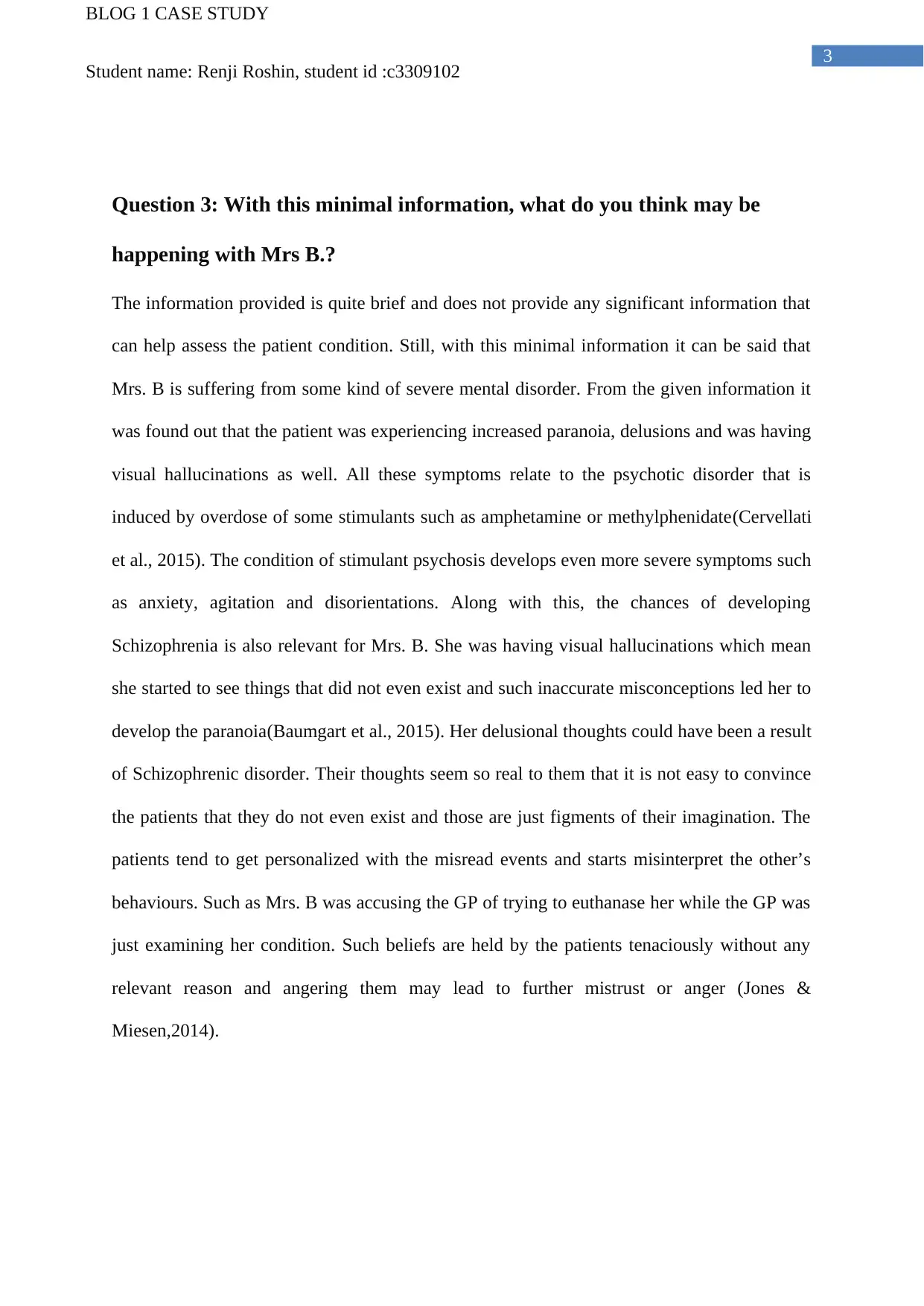
3
BLOG 1 CASE STUDY
Student name: Renji Roshin, student id :c3309102
Question 3: With this minimal information, what do you think may be
happening with Mrs B.?
The information provided is quite brief and does not provide any significant information that
can help assess the patient condition. Still, with this minimal information it can be said that
Mrs. B is suffering from some kind of severe mental disorder. From the given information it
was found out that the patient was experiencing increased paranoia, delusions and was having
visual hallucinations as well. All these symptoms relate to the psychotic disorder that is
induced by overdose of some stimulants such as amphetamine or methylphenidate(Cervellati
et al., 2015). The condition of stimulant psychosis develops even more severe symptoms such
as anxiety, agitation and disorientations. Along with this, the chances of developing
Schizophrenia is also relevant for Mrs. B. She was having visual hallucinations which mean
she started to see things that did not even exist and such inaccurate misconceptions led her to
develop the paranoia(Baumgart et al., 2015). Her delusional thoughts could have been a result
of Schizophrenic disorder. Their thoughts seem so real to them that it is not easy to convince
the patients that they do not even exist and those are just figments of their imagination. The
patients tend to get personalized with the misread events and starts misinterpret the other’s
behaviours. Such as Mrs. B was accusing the GP of trying to euthanase her while the GP was
just examining her condition. Such beliefs are held by the patients tenaciously without any
relevant reason and angering them may lead to further mistrust or anger (Jones &
Miesen,2014).
BLOG 1 CASE STUDY
Student name: Renji Roshin, student id :c3309102
Question 3: With this minimal information, what do you think may be
happening with Mrs B.?
The information provided is quite brief and does not provide any significant information that
can help assess the patient condition. Still, with this minimal information it can be said that
Mrs. B is suffering from some kind of severe mental disorder. From the given information it
was found out that the patient was experiencing increased paranoia, delusions and was having
visual hallucinations as well. All these symptoms relate to the psychotic disorder that is
induced by overdose of some stimulants such as amphetamine or methylphenidate(Cervellati
et al., 2015). The condition of stimulant psychosis develops even more severe symptoms such
as anxiety, agitation and disorientations. Along with this, the chances of developing
Schizophrenia is also relevant for Mrs. B. She was having visual hallucinations which mean
she started to see things that did not even exist and such inaccurate misconceptions led her to
develop the paranoia(Baumgart et al., 2015). Her delusional thoughts could have been a result
of Schizophrenic disorder. Their thoughts seem so real to them that it is not easy to convince
the patients that they do not even exist and those are just figments of their imagination. The
patients tend to get personalized with the misread events and starts misinterpret the other’s
behaviours. Such as Mrs. B was accusing the GP of trying to euthanase her while the GP was
just examining her condition. Such beliefs are held by the patients tenaciously without any
relevant reason and angering them may lead to further mistrust or anger (Jones &
Miesen,2014).
Secure Best Marks with AI Grader
Need help grading? Try our AI Grader for instant feedback on your assignments.
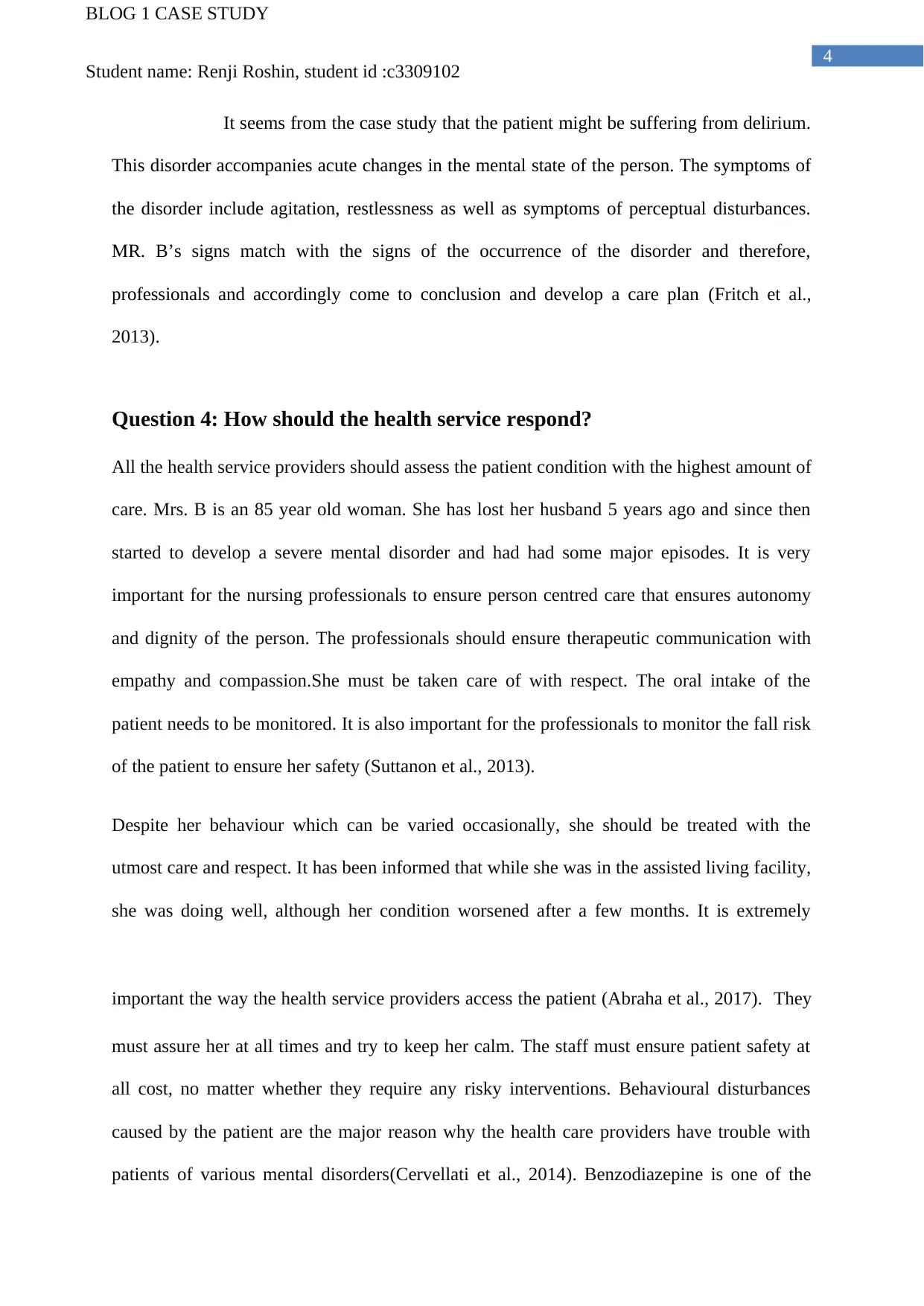
4
BLOG 1 CASE STUDY
Student name: Renji Roshin, student id :c3309102
It seems from the case study that the patient might be suffering from delirium.
This disorder accompanies acute changes in the mental state of the person. The symptoms of
the disorder include agitation, restlessness as well as symptoms of perceptual disturbances.
MR. B’s signs match with the signs of the occurrence of the disorder and therefore,
professionals and accordingly come to conclusion and develop a care plan (Fritch et al.,
2013).
Question 4: How should the health service respond?
All the health service providers should assess the patient condition with the highest amount of
care. Mrs. B is an 85 year old woman. She has lost her husband 5 years ago and since then
started to develop a severe mental disorder and had had some major episodes. It is very
important for the nursing professionals to ensure person centred care that ensures autonomy
and dignity of the person. The professionals should ensure therapeutic communication with
empathy and compassion.She must be taken care of with respect. The oral intake of the
patient needs to be monitored. It is also important for the professionals to monitor the fall risk
of the patient to ensure her safety (Suttanon et al., 2013).
Despite her behaviour which can be varied occasionally, she should be treated with the
utmost care and respect. It has been informed that while she was in the assisted living facility,
she was doing well, although her condition worsened after a few months. It is extremely
important the way the health service providers access the patient (Abraha et al., 2017). They
must assure her at all times and try to keep her calm. The staff must ensure patient safety at
all cost, no matter whether they require any risky interventions. Behavioural disturbances
caused by the patient are the major reason why the health care providers have trouble with
patients of various mental disorders(Cervellati et al., 2014). Benzodiazepine is one of the
BLOG 1 CASE STUDY
Student name: Renji Roshin, student id :c3309102
It seems from the case study that the patient might be suffering from delirium.
This disorder accompanies acute changes in the mental state of the person. The symptoms of
the disorder include agitation, restlessness as well as symptoms of perceptual disturbances.
MR. B’s signs match with the signs of the occurrence of the disorder and therefore,
professionals and accordingly come to conclusion and develop a care plan (Fritch et al.,
2013).
Question 4: How should the health service respond?
All the health service providers should assess the patient condition with the highest amount of
care. Mrs. B is an 85 year old woman. She has lost her husband 5 years ago and since then
started to develop a severe mental disorder and had had some major episodes. It is very
important for the nursing professionals to ensure person centred care that ensures autonomy
and dignity of the person. The professionals should ensure therapeutic communication with
empathy and compassion.She must be taken care of with respect. The oral intake of the
patient needs to be monitored. It is also important for the professionals to monitor the fall risk
of the patient to ensure her safety (Suttanon et al., 2013).
Despite her behaviour which can be varied occasionally, she should be treated with the
utmost care and respect. It has been informed that while she was in the assisted living facility,
she was doing well, although her condition worsened after a few months. It is extremely
important the way the health service providers access the patient (Abraha et al., 2017). They
must assure her at all times and try to keep her calm. The staff must ensure patient safety at
all cost, no matter whether they require any risky interventions. Behavioural disturbances
caused by the patient are the major reason why the health care providers have trouble with
patients of various mental disorders(Cervellati et al., 2014). Benzodiazepine is one of the
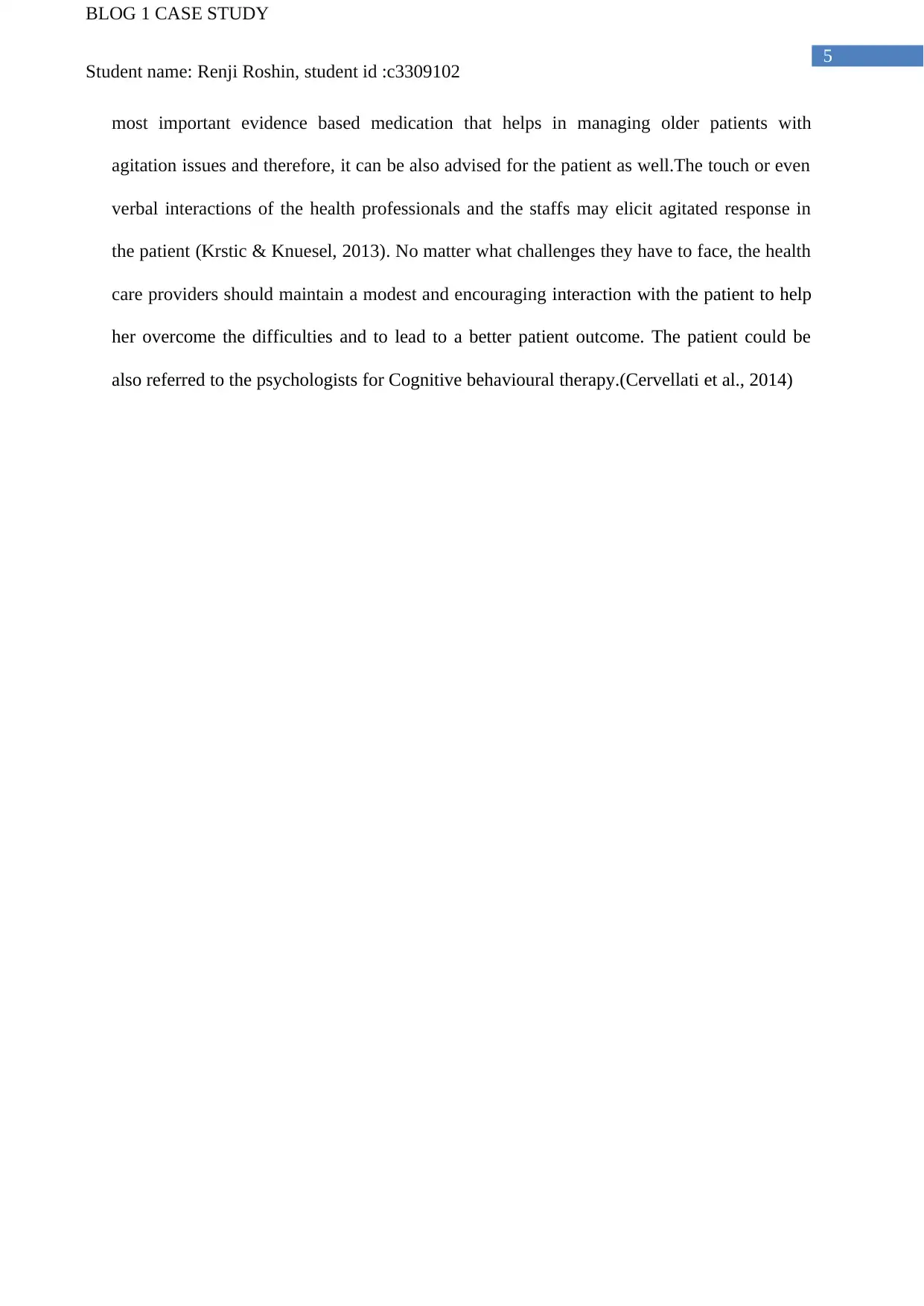
5
BLOG 1 CASE STUDY
Student name: Renji Roshin, student id :c3309102
most important evidence based medication that helps in managing older patients with
agitation issues and therefore, it can be also advised for the patient as well.The touch or even
verbal interactions of the health professionals and the staffs may elicit agitated response in
the patient (Krstic & Knuesel, 2013). No matter what challenges they have to face, the health
care providers should maintain a modest and encouraging interaction with the patient to help
her overcome the difficulties and to lead to a better patient outcome. The patient could be
also referred to the psychologists for Cognitive behavioural therapy.(Cervellati et al., 2014)
BLOG 1 CASE STUDY
Student name: Renji Roshin, student id :c3309102
most important evidence based medication that helps in managing older patients with
agitation issues and therefore, it can be also advised for the patient as well.The touch or even
verbal interactions of the health professionals and the staffs may elicit agitated response in
the patient (Krstic & Knuesel, 2013). No matter what challenges they have to face, the health
care providers should maintain a modest and encouraging interaction with the patient to help
her overcome the difficulties and to lead to a better patient outcome. The patient could be
also referred to the psychologists for Cognitive behavioural therapy.(Cervellati et al., 2014)
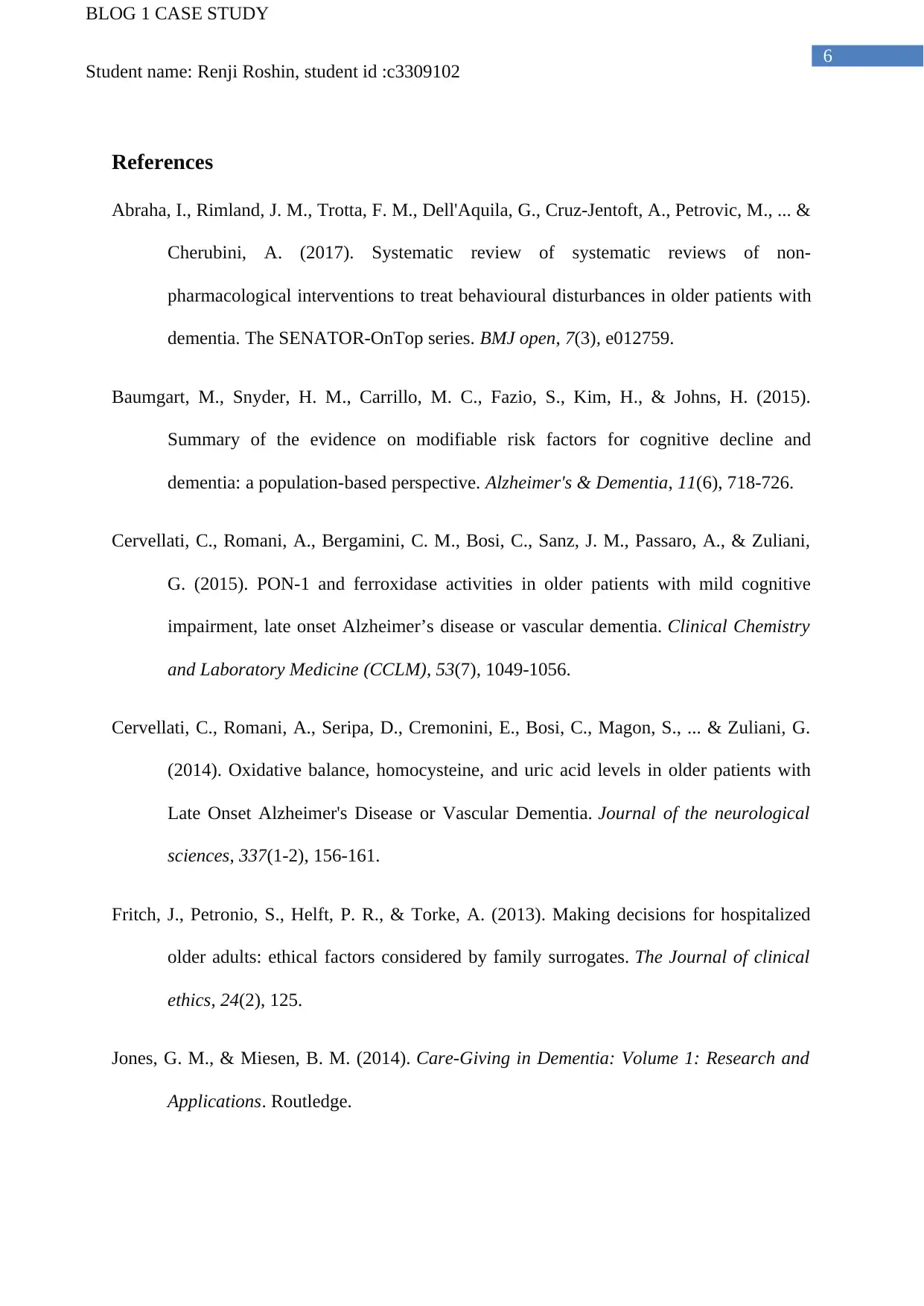
6
BLOG 1 CASE STUDY
Student name: Renji Roshin, student id :c3309102
References
Abraha, I., Rimland, J. M., Trotta, F. M., Dell'Aquila, G., Cruz-Jentoft, A., Petrovic, M., ... &
Cherubini, A. (2017). Systematic review of systematic reviews of non-
pharmacological interventions to treat behavioural disturbances in older patients with
dementia. The SENATOR-OnTop series. BMJ open, 7(3), e012759.
Baumgart, M., Snyder, H. M., Carrillo, M. C., Fazio, S., Kim, H., & Johns, H. (2015).
Summary of the evidence on modifiable risk factors for cognitive decline and
dementia: a population-based perspective. Alzheimer's & Dementia, 11(6), 718-726.
Cervellati, C., Romani, A., Bergamini, C. M., Bosi, C., Sanz, J. M., Passaro, A., & Zuliani,
G. (2015). PON-1 and ferroxidase activities in older patients with mild cognitive
impairment, late onset Alzheimer’s disease or vascular dementia. Clinical Chemistry
and Laboratory Medicine (CCLM), 53(7), 1049-1056.
Cervellati, C., Romani, A., Seripa, D., Cremonini, E., Bosi, C., Magon, S., ... & Zuliani, G.
(2014). Oxidative balance, homocysteine, and uric acid levels in older patients with
Late Onset Alzheimer's Disease or Vascular Dementia. Journal of the neurological
sciences, 337(1-2), 156-161.
Fritch, J., Petronio, S., Helft, P. R., & Torke, A. (2013). Making decisions for hospitalized
older adults: ethical factors considered by family surrogates. The Journal of clinical
ethics, 24(2), 125.
Jones, G. M., & Miesen, B. M. (2014). Care-Giving in Dementia: Volume 1: Research and
Applications. Routledge.
BLOG 1 CASE STUDY
Student name: Renji Roshin, student id :c3309102
References
Abraha, I., Rimland, J. M., Trotta, F. M., Dell'Aquila, G., Cruz-Jentoft, A., Petrovic, M., ... &
Cherubini, A. (2017). Systematic review of systematic reviews of non-
pharmacological interventions to treat behavioural disturbances in older patients with
dementia. The SENATOR-OnTop series. BMJ open, 7(3), e012759.
Baumgart, M., Snyder, H. M., Carrillo, M. C., Fazio, S., Kim, H., & Johns, H. (2015).
Summary of the evidence on modifiable risk factors for cognitive decline and
dementia: a population-based perspective. Alzheimer's & Dementia, 11(6), 718-726.
Cervellati, C., Romani, A., Bergamini, C. M., Bosi, C., Sanz, J. M., Passaro, A., & Zuliani,
G. (2015). PON-1 and ferroxidase activities in older patients with mild cognitive
impairment, late onset Alzheimer’s disease or vascular dementia. Clinical Chemistry
and Laboratory Medicine (CCLM), 53(7), 1049-1056.
Cervellati, C., Romani, A., Seripa, D., Cremonini, E., Bosi, C., Magon, S., ... & Zuliani, G.
(2014). Oxidative balance, homocysteine, and uric acid levels in older patients with
Late Onset Alzheimer's Disease or Vascular Dementia. Journal of the neurological
sciences, 337(1-2), 156-161.
Fritch, J., Petronio, S., Helft, P. R., & Torke, A. (2013). Making decisions for hospitalized
older adults: ethical factors considered by family surrogates. The Journal of clinical
ethics, 24(2), 125.
Jones, G. M., & Miesen, B. M. (2014). Care-Giving in Dementia: Volume 1: Research and
Applications. Routledge.
Paraphrase This Document
Need a fresh take? Get an instant paraphrase of this document with our AI Paraphraser
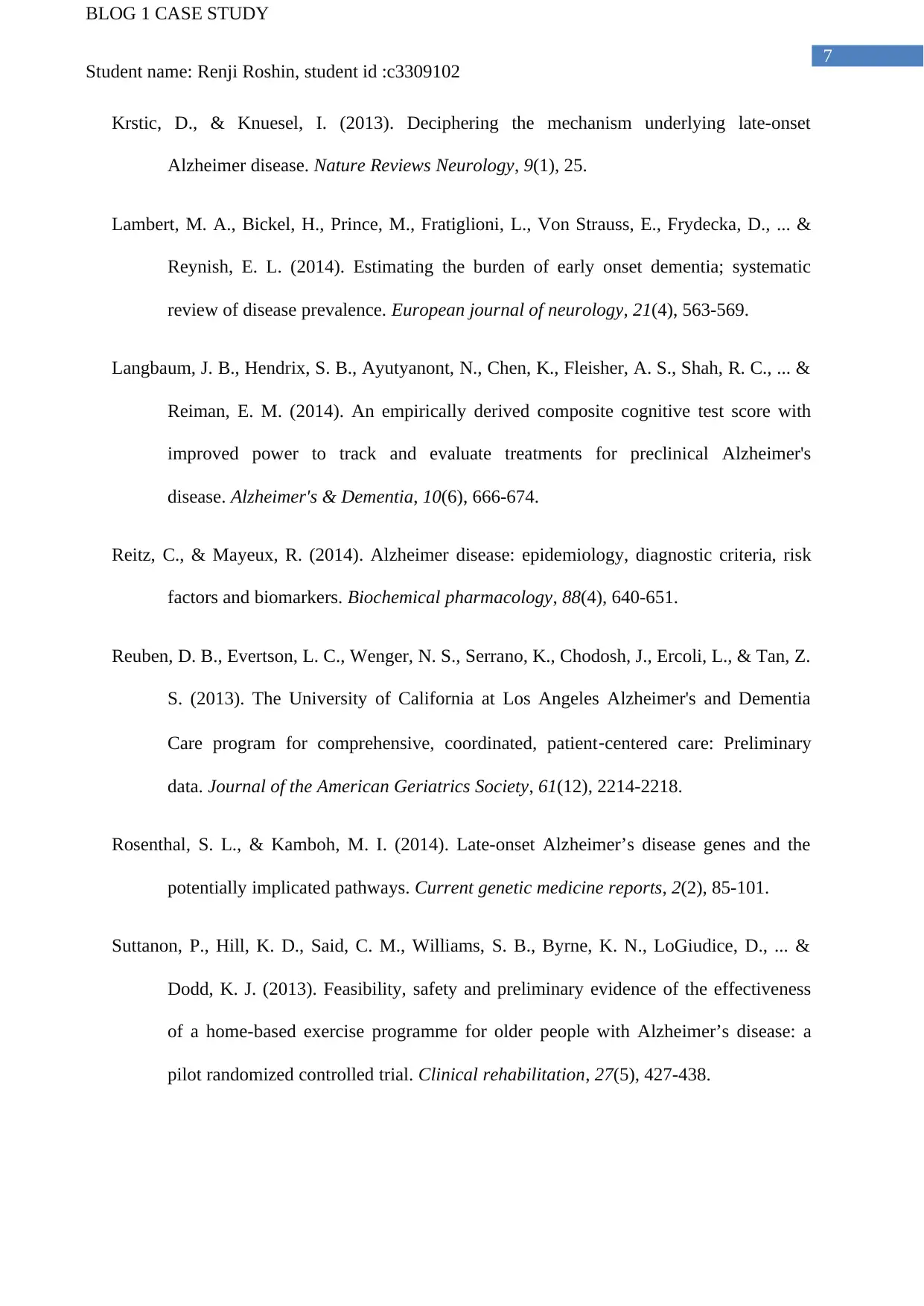
7
BLOG 1 CASE STUDY
Student name: Renji Roshin, student id :c3309102
Krstic, D., & Knuesel, I. (2013). Deciphering the mechanism underlying late-onset
Alzheimer disease. Nature Reviews Neurology, 9(1), 25.
Lambert, M. A., Bickel, H., Prince, M., Fratiglioni, L., Von Strauss, E., Frydecka, D., ... &
Reynish, E. L. (2014). Estimating the burden of early onset dementia; systematic
review of disease prevalence. European journal of neurology, 21(4), 563-569.
Langbaum, J. B., Hendrix, S. B., Ayutyanont, N., Chen, K., Fleisher, A. S., Shah, R. C., ... &
Reiman, E. M. (2014). An empirically derived composite cognitive test score with
improved power to track and evaluate treatments for preclinical Alzheimer's
disease. Alzheimer's & Dementia, 10(6), 666-674.
Reitz, C., & Mayeux, R. (2014). Alzheimer disease: epidemiology, diagnostic criteria, risk
factors and biomarkers. Biochemical pharmacology, 88(4), 640-651.
Reuben, D. B., Evertson, L. C., Wenger, N. S., Serrano, K., Chodosh, J., Ercoli, L., & Tan, Z.
S. (2013). The University of California at Los Angeles Alzheimer's and Dementia
Care program for comprehensive, coordinated, patient‐centered care: Preliminary
data. Journal of the American Geriatrics Society, 61(12), 2214-2218.
Rosenthal, S. L., & Kamboh, M. I. (2014). Late-onset Alzheimer’s disease genes and the
potentially implicated pathways. Current genetic medicine reports, 2(2), 85-101.
Suttanon, P., Hill, K. D., Said, C. M., Williams, S. B., Byrne, K. N., LoGiudice, D., ... &
Dodd, K. J. (2013). Feasibility, safety and preliminary evidence of the effectiveness
of a home-based exercise programme for older people with Alzheimer’s disease: a
pilot randomized controlled trial. Clinical rehabilitation, 27(5), 427-438.
BLOG 1 CASE STUDY
Student name: Renji Roshin, student id :c3309102
Krstic, D., & Knuesel, I. (2013). Deciphering the mechanism underlying late-onset
Alzheimer disease. Nature Reviews Neurology, 9(1), 25.
Lambert, M. A., Bickel, H., Prince, M., Fratiglioni, L., Von Strauss, E., Frydecka, D., ... &
Reynish, E. L. (2014). Estimating the burden of early onset dementia; systematic
review of disease prevalence. European journal of neurology, 21(4), 563-569.
Langbaum, J. B., Hendrix, S. B., Ayutyanont, N., Chen, K., Fleisher, A. S., Shah, R. C., ... &
Reiman, E. M. (2014). An empirically derived composite cognitive test score with
improved power to track and evaluate treatments for preclinical Alzheimer's
disease. Alzheimer's & Dementia, 10(6), 666-674.
Reitz, C., & Mayeux, R. (2014). Alzheimer disease: epidemiology, diagnostic criteria, risk
factors and biomarkers. Biochemical pharmacology, 88(4), 640-651.
Reuben, D. B., Evertson, L. C., Wenger, N. S., Serrano, K., Chodosh, J., Ercoli, L., & Tan, Z.
S. (2013). The University of California at Los Angeles Alzheimer's and Dementia
Care program for comprehensive, coordinated, patient‐centered care: Preliminary
data. Journal of the American Geriatrics Society, 61(12), 2214-2218.
Rosenthal, S. L., & Kamboh, M. I. (2014). Late-onset Alzheimer’s disease genes and the
potentially implicated pathways. Current genetic medicine reports, 2(2), 85-101.
Suttanon, P., Hill, K. D., Said, C. M., Williams, S. B., Byrne, K. N., LoGiudice, D., ... &
Dodd, K. J. (2013). Feasibility, safety and preliminary evidence of the effectiveness
of a home-based exercise programme for older people with Alzheimer’s disease: a
pilot randomized controlled trial. Clinical rehabilitation, 27(5), 427-438.

8
BLOG 1 CASE STUDY
Student name: Renji Roshin, student id :c3309102
Vieira, R. T., Caixeta, L., Machado, S., Silva, A. C., Nardi, A. E., Arias-Carrión, O., & Carta,
M. G. (2013). Epidemiology of early-onset dementia: a review of the
literature. Clinical practice and epidemiology in mental health: CP & EMH, 9, 88.
BLOG 1 CASE STUDY
Student name: Renji Roshin, student id :c3309102
Vieira, R. T., Caixeta, L., Machado, S., Silva, A. C., Nardi, A. E., Arias-Carrión, O., & Carta,
M. G. (2013). Epidemiology of early-onset dementia: a review of the
literature. Clinical practice and epidemiology in mental health: CP & EMH, 9, 88.
1 out of 9
Related Documents
Your All-in-One AI-Powered Toolkit for Academic Success.
+13062052269
info@desklib.com
Available 24*7 on WhatsApp / Email
![[object Object]](/_next/static/media/star-bottom.7253800d.svg)
Unlock your academic potential
© 2024 | Zucol Services PVT LTD | All rights reserved.





